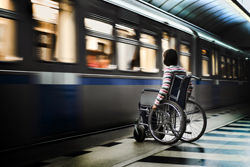The road is open for universal public transport access
It's an experience we have all shared, some more than others, unfortunately. Equal opportunity to access to public transport is a right but is not always attainable. Disadvantage comes in many guises to all social groups. As a mother with a push chair, a disabled person in a wheelchair or simply wading through a difficult booking procedure, the effect is the same. The denial of an inalienable right. The objective of the FP6 project Uniaccess was to redress the injustice and ensure universal access to all forms of transport – buses, trains and airplanes alike. The list of criteria covered and stakeholders involved are extensive. Major factors include good repair of vehicles, the use of available space efficiently, reduction of time wasting and safety assured. This ambitious goal requires a high degree of coordination. All parties must participate equally with the objectives of universal access at the forefront of their minds. End-user feedback is a very important element - their needs must be communicated and outcomes validated. Designers and manufacturers must not only use state-of-the-art technology which works in reality as it did in the laboratory, but it has to be cost-effective. The response to these demands came as three key results achieved by the project. Essential is the accessibility review which unearthed shortcomings and successes in infrastructure, vehicles, legislature and standards which varied from country to country. The second achievement is a roadmap. Logically organised, it starts from the planning stage where travel information and booking occur through to the final stage at journey's end. Whether the steps in the procedure were fraught with difficulty or proceeded smoothly is apparent through the scenario-based approach. The collected information was then organised for application of the most technologically advanced solutions to accessibility problems. Experts collaborated to provide the input to the development with feedback from all key users, from the passenger to the maintenance manager. Regional differences in policy, a major problem to date are ironed out to make the initiative seamless across Europe. Legislation, standards and enforcement were all reviewed with recommendations geared to pan-European requirement. For abolition of discrimination, there is a centralised agency. The achievements of the Uniaccess project clearly map out the route, making sure everyone regardless of status, can take public transport to the destination of their choice. Nobody would deny it's a rocky road to travel but the way ahead, thanks to Uniaccess, may well be the freeway we are looking for.







